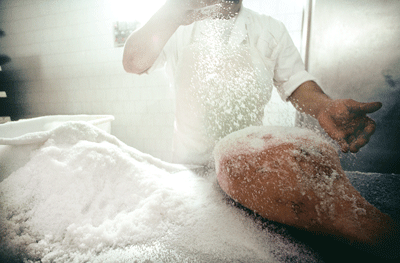
A Simple Science
There are two ways to cure the hind leg of a pig: the dry way and the wet way.
There are two ways to cure the hind leg of a pig: the dry way and the wet way. Dry-curing, the original method for making ham, is a straightforward process of salting and aging that has been around for thousands of years. First, the ham is rubbed with ample amounts of salt, that most ancient and reliable of preservatives. The salt draws moisture out of the meat's tissues through osmosis—the movement of water from areas of low salt concentration (in this case, the interior of the ham) to areas of high salt concentration (the ham's salty surface)—which inhibits the growth of harmful bacteria and molds. Most American country hams are covered in a layer of salt, then left to cure for about 50 days. Italian prosciutto is salted in two phases for a total of about 24 days.
After the ham is washed, it is stored at temperatures between 40 and 50 degrees Fahrenheit for several weeks, during which time the residual salt that is concentrated in the outer part of the meat begins to penetrate into the flesh through a process called equalization. The ham is then hung to age for anywhere from three months to two years, during which time it loses more moisture. (A dry-cured ham will ultimately shed between 18 and 36 percent of its original weight.) Its flavor intensifies, and the salinity breaks down the meat's protein filaments, lending raw dry-cured flesh its translucence and dense yet tender texture. Meanwhile, enzymes break down flavorless proteins into savory amino acids, such as glutamate, which impart a luscious, umami flavor. In many parts of the world—Germany, eastern Europe, and much of the U.S.—another step is added: smoking, which gives the ham more flavor, kills microbes, and repels insects. Many producers also add small amounts of nitrates and nitrites as preservatives.
Historically, virtually all ham was dry-cured, and it was a seasonal food, produced only where the weather cooperated: if the climate was too cold, the hams would freeze and not cure properly; if it was too humid, the hams would spoil. In Italy, China, the American South, and other ham-friendly parts of the world, hogs were traditionally slaughtered after fall's first cold snap, and the first hams were ready to eat in the spring (which is why ham became a traditional food for Easter supper). Those that aged longer, left to undergo what's known as "the summer sweats," were prized for their more concentrated flavor and texture.
The advent of refrigeration changed all that. Not only did it allow people to dry-cure hams in temperature-controlled rooms at any time of year, but it also led to the proliferation of wet-curing techniques that preserved the meat to a lesser degree but enough that the hams kept well if refrigerated. During wet-curing, otherwise known as brining, the ham is immersed in or injected with a solution of water, salt, and sometimes sugar and spices. Wet-curing is easy and fast—the hams are often finished in a day or two. In the U.S., such hams came to be called city hams (to distinguish them from their "country" cousins) and quickly became popular. In France, jambon de Paris is a well-loved wet-cured ham; other cultures developed their own versions. Wet-cured hams, though often plumper and juicier than dry-cured ones thanks to the brining solution, tend to be milder tasting because the process dilutes the meat's flavor.
Keep Reading
Continue to Next Story










